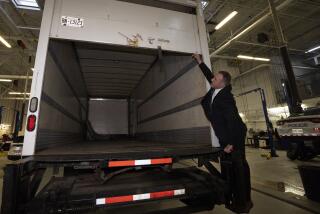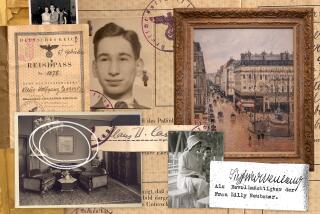Swiss Served as Bankers for Nazis, U.S. Report Says
WASHINGTON — A comprehensive U.S. government study of the gold plundered by the Nazis during World War II--part of it from Holocaust victims--harshly criticizes Switzerland for accepting the bounty, and it faults the United States and its allies for failing to press for a proper redistribution of the loot.
The stolen gold--most of which came from the official reserves of occupied nations--was sold by the Nazis to finance their war machine.
The 212-page report, compiled by a team of officials headed by Commerce Undersecretary Stuart E. Eizenstat, blasted Swiss banks for accepting the gold and serving as Germany’s chief source of credit, thereby sustaining the Nazi war effort.
“Neutrality collided with morality,” the report declared.
After the war, the gold was either retained by the Swiss or returned to successor governments of Nazi-occupied countries, the study released Wednesday concluded.
Conclusive evidence that gold from Holocaust victims either remained in Switzerland or ended up in the postwar treasuries of Western Europe was a key finding of the study, the most extensive undertaken so far into one of the darkest, most tangled chapters of the 20th century.
The finding is expected to provide an important boost to efforts by major Jewish organizations to win additional compensation for Holocaust survivors and the heirs of victims.
Eizenstat said that in light of the report, the U.S. will recommend that the $70 million in recovered Nazi loot that has not been redistributed be given to Holocaust survivors.
“It would help them live out their declining years in dignity,” he said, noting that such a move is particularly important for a group of 30,000 to 50,000 people who survived the Holocaust, only to be trapped behind the Iron Curtain for nearly half a century. He called this group “double victims.”
Israel Singer, a senior figure in the World Jewish Congress, praised the idea and called the report “an important step toward the real truth.”
Eizenstat said it had not been possible to determine how much of the estimated $580 million in plundered Nazi gold actually came from individual victims and how much was so-called monetary gold--gold taken from national treasuries.
“Perhaps with more records we’ll be able to find it, but it may be that we’ll never fully know the amount,” he said. “Certainly it was a considerable sum. Relative to the amount of monetary gold from central banks [$580 million], it was a relatively small amount. But for those from whom it was taken, it was obviously their life savings.”
A combination of the declassification of secret wartime documents, the end of the Cold War, pressure from aging Holocaust survivors and a younger generation demanding answers brought about the report more than 50 years after World War II’s end.
More enlightenment may come--the study called for an international conference at which historians and other experts can exchange knowledge about the flow of Nazi assets.
Wednesday’s document faults the U.S. and its allies for not putting more pressure on neutral countries to return more of the Nazi assets in their banks.
“Neither the U.S. nor the allies pressed . . . hard enough to fulfill their moral obligations to help Holocaust survivors,” Eizenstat said.
The harshest criticism was reserved for Switzerland, which by U.S. estimates held as much as $289 million in looted Nazi gold and between $250 million and $500 million in other German assets at the end of the war. After extremely tough negotiations, the Swiss government turned over only a fraction of this wealth to the Allies for redistribution.
“The Swiss team were obdurate negotiators, using legalistic positions to defend their every interest, regardless of the moral issues also at stake,” the report said.
The report is certain to add fuel to an already heated debate that began in earnest only last year.
It is a debate that has belatedly questioned the long-held Swiss self-image as a brave and plucky people whose steady neutrality during the war masked a quiet support for the Allied cause.
Another less flattering image of the tiny mountain country has emerged: that of a country that happily exploited its wartime neutrality to act as the Nazis’ international banker and money launderer, then steadfastly refused to give up much of the looted wealth after the war.
One commission in Switzerland is investigating to what extent local banks may have concealed the existence of unclaimed numbered accounts held by Holocaust victims, while a second is studying whether Nazi assets were deliberately hidden by Swiss authorities at the end of the war.
Despite criticism of Swiss actions, Wednesday’s study also said that no evidence had been found that Swiss authorities knew during the war that they were receiving the gold of Holocaust victims. The study said the German Reichsbank tried to disguise victims’ gold by melting it down and mixing it with gold looted from the central banks of occupied countries before selling it to Switzerland.
Swiss officials were quick to highlight this point.
At a news conference in Washington, Thomas Borer, a senior Swiss diplomat, described the finding that victims’ gold was in Reichsbank ingots as “almost beyond comprehension.”
Borer heads a Swiss government task force working with Jewish organizations to end a dispute over Swiss compensation for Holocaust victims.
Wednesday’s report also seemed to undercut allegations made by some Jewish organizations that as much as $7 billion worth of gold and other assets confiscated from Holocaust victims remains in Swiss hands.
Eizenstat told reporters that financial documents discovered only in the last two weeks showed that during the war the German government had a special account at the Reichsbank, where it deposited jewelry, watches and even dental fillings confiscated from Holocaust victims.
Pointing to an enlarged copy of the account’s statement on a specific day, Eizenstat noted the recorded deposit of 854 rings, one trunk of silver objects and one trunk of dental gold.
“And this appears frequently in Reichsbank records,” he said.
More to Read
Sign up for Essential California
The most important California stories and recommendations in your inbox every morning.
You may occasionally receive promotional content from the Los Angeles Times.










